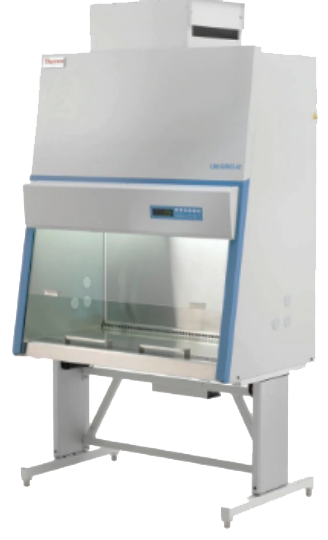
A Biolgical Safety Cabinet (BSC) is an enclosed, ventilated lab workspace for safely handling materials that are contaminated (or potentially contaminated) with pathogens. BSCs are often used to maintain aseptic conditions.
|
Class |
I |
II |
III |
|||||
|
Type |
|
A1 |
A2 (A/B3) |
B1 |
B2 |
|
||
|
Face Velocity (lfm) |
75 |
75 |
100 |
100 |
100 |
N/A |
||
|
Recirculated Air |
0% |
70% |
70% |
30% |
0% |
0% |
||
|
Exhaust Air |
100% |
30% |
30% |
70% |
100% |
100% |
||
|
Ducting |
Hard |
Unducted |
Thimble |
Unducted |
Thimble |
Hard |
Hard |
Hard |
|
Use Volatile Chemicals |
Small Amounts |
No |
Minute Amounts |
No |
Minute Amounts |
Minute Amounts |
Small Amounts |
Yes |
|
Personnel/ |
Yes |
Yes |
Yes |
Yes |
Yes |
Yes |
||
|
Product Protection |
No |
Yes |
Yes |
Yes |
Yes |
Maybe |
||
Continuous Inward Airflow protects the user from aerosols.
Filtered Downward Laminar Airflow & Exhaust
BSCs use High-Efficiency Particulate Air (HEPA) filters.
- The minimum efficiency is 99.97% at 0.3 µm.
- HEPA Filters do not remove gasses or vapors
Ducting and Alarms
Hard-ducted BSCs exhaust through the building’s fume hood exhaust system.
Thimble-ducted (canopy) exhaust draws air from both the BSC and the room.
Unducted BSCs exhaust HEPA-filtered air back into the room.
Alarms are required on ducted BSCs to notify the user if the building’s exhaust system fails. In a hard-ducted BSC, immediately stop work and close the sash when the alarm sounds.

BSCs must be certified per NSF/ANSI 49 Standards
- When new (before first use)
- After repair/service
- Every year
- If relocated (even within the same room)
Contact OEHS at 1-801-581-6590.
BSCs should be located away from other sources of airflow such as doors, windows, supply air vents, high-traffic areas and other lab equipment (e.g., BSCs, fume hoods, incubators). Consult with OEHS Biosafety on room layout plans before installing BSCs to ensure that the proposed location does not compromise protection
- Accessories: Open flames are not permitted in BSCs because they disrupt airflow, damage the HEPA filter, and can lead to a build-up of flammable gases. Ordering BSCs without gas ports is recommended.
- Lighting: The use of UV light in BSCs is strongly discouraged by the NIH, CDC and the University of Utah. If UV light is used, personnel must leave the room while the light is on.
- Customization: BSCs can be customized at the factory to accommodate, e.g., microscope face pieces, large equipment, dunk tanks or cage changing. Consult with vendors about your needs to identify options.
- Materials: Bleach and other corrosive chemicals can damage steel surfaces. Follow bleach decontamination by wiping the surface with 70% ethanol or sterile water to protect against corrosion.
- Sizing: BSCs should have several inches of clearance from the wall(s) and other equipment and are designed for use by one person at a time. Consider multiple smaller BSCs instead of one larger BSC if simultaneous work scheduling is anticipated.
Adapted from UCLA EH&S guidance
